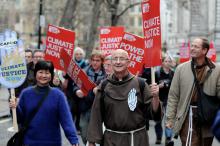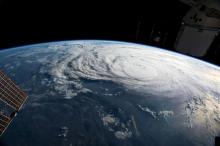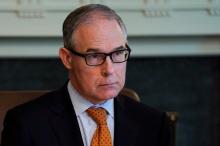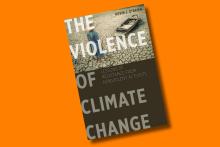Climate change

IT'S EASY to get discouraged. The Paris climate accord is the most significant multinational agreement yet to address climate change. Every country in the world, and Palestine, signed it. “That’s a lot of countries!” said former President Obama.
But on June 1, 2017, President Trump announced that the United States would withdraw from the Paris Agreement. By abdicating U.S. presidential leadership, Trump left it to the rest of the world’s governments to address the greatest crisis humanity has ever seen.
The depressing actions of the current administration are legion. Using federal agencies and executive orders, Trump is dismantling the climate progress so many have worked for. In September, federal agencies deregulated the release of methane gas, which traps about 25 times more heat in the atmosphere than carbon dioxide does. The Trump administration has allowed land set aside as national monuments to be pillaged for oil and gas drilling and mineral extraction. A fossil fuel corporate lawyer now working for the Environmental Protection Agency has dismantled our clean air regulations. The EPA has established incentives to encourage more than 300 coal plants to continue polluting our air and land.
If human-induced atmospheric warming continues at the current rate, the world will cross the 1.5-degree Celsius threshold of global temperature increase around 2040, much earlier than previously estimated, according to an October 2018 report from the International Panel on Climate Change, the first update since the Paris Agreement. Without aggressive action, food shortages and wildfires will worsen, water shortages will hit urban areas, killer heatwaves and violent storms will be more frequent, coastal areas will experience sea level rise, and populations will migrate. Humanity must become laser focused on achieving net zero emissions if creation as we know it is to survive. In other words, it’s now or never on climate change.

A dystopian scene is unfolding across California. Charred car skeletons sit idle on the side of roads in the working-class town of Paradise, Calif. In one video, a camera pans to reveal what looks like an apocalyptic movie set — passing the remains of an abandoned school bus, begging us to ask what happened to those who were inside.

O God, as the prophet proclaimed long ago,
You care for your earth and your gifts overflow.
Though sin leads to things that disrupt and destroy,
You work to redeem and to bring life and joy.
1. Trump Cannot Define Away my Existence
The administration seems to think transgender people like me are as imaginary as hippogriffs.
2. The Secret Anxiety of the Upwardly Mobile
Children who do better than their parents often must choose between blending in and standing out.

Juliana was in high school when she first joined Our Children’s Trust to sue the Governor of Oregon for a stable climate. During my environmental education classes, I’ve discussed the litigation to illustrate the importance of a long-term view even for an urgent planetary crisis. When my undergraduates prepare conservation workshops for local schools, they know that Juliana once sat in their places. She hopes to advocate for them in the U.S. District Courthouse in Eugene, Ore. in what may be the lawsuit of their lifetimes. And regardless of this Supreme Court’s decision, youth will gather on the courthouse steps to call for their right to a stable climate.

A new United Nations report by the Intergovernmental Panel on Climate Change (IPCC ) paints a dire future for life on earth. Even if nations are able to fulfill commitments made during the 2016 Paris Agreement, the report asserts that the world is still headed in the direction of warming by 3 degrees Celsius or more - a temperature increase that would drive worsening food shortages, wild fires, heatwaves, coastal flooding, and poverty.
1. Scientist Calmly Explain That Civilization Is at Stake if We Don’t Act Now
“The world has already warmed by about 1 degree C and without a global coordinated effort, the world will reach 1.5 degrees in as little as 12 years. ‘Several hundred million’ lives are at stake, according to the Intergovernmental Panel on Climate Change.”
2. To Protect the Environment, Buddhist Monks Are Ordaining Trees
To harm an ordained monk is a religious taboo and legal offense. An ordination extends this sacred status to the tree. Communities that ordain trees often patrol the forest, taking photos of illegal activity and reporting wrongdoers.

EVERY POLITICAL LEADER on the planet should be stuck aboard a jet and taken north to see the Greenland ice sheet—it would be well worth the carbon emissions to show them just how fast climate change is now happening.
Case in point: I was aboard a boat en route to the Qaterlait glacier in August when I looked up at the GPS unit above the captain’s head. It showed an icon of the boat, steaming rapidly across ... solid land. That’s because when the chart was drawn a decade ago, the bay we were crossing didn’t exist: It was still solid ice.
I had the great fortune of journeying to the ice sheet with two young poets—a Greenlander named Aka Niviâna and a native of the Marshall Islands, Kathy Jetñil-Kijiner. These two remarkable women were at opposite ends of the same story—as the ice melted, the traditional life of Greenlanders was beginning to disappear. And the water that poured into the oceans is now drowning low-lying islands such as the Marshalls.

A desire to care for the environment also stems from the Christian traditions of compassion and love. Congregations have long worked to alleviate hunger, lift the poor and the vulnerable, and comfort the sick. Creating community gardens, making energy more affordable, and working to avoid the worst effects of climate change, which are disproportionately felt by low-income communities, stem from these traditions.

I confess it is so easy, and tempting, for me to become exorcised over Donald Trump’s daily deceits, narcissism, and shredding of public virtue. But a deeper threat looms, begun many decades before. Humanity is destroying the integrity of God’s creation. The most flagrant and catastrophic assaults are now altering the globe’s climate in ways that already are impacting the world’s most vulnerable people and threatening us all. President Trump’s policies are aimed at liberating constraints on the burning of more coal and carbon, come hell or high water.

It seems the role of climate change is seldom mentioned in many or even most news stories about the multitude of fires and heat waves. In part, this is because the issue of attribution is not usually clear. The argument is that there have always been wildfires, and how can we attribute any particular wildfire to climate change?

“Our current economies are running a Ponzi scheme with our planet,” Mathis Wackernagel, chief executive and co-founder of Global Footprint Network, said. “We are borrowing the Earth’s future resources to operate our economies in the present. Like any Ponzi scheme, this works for some time. But as nations, companies, or households dig themselves deeper and deeper into debt, they eventually fall apart.”
6. Twenty-foot-tall rice could feed a flooded planet
When Climate change floods regions around the world, deepwater rice could thrive while other species die.

U.S. Environmental Protection Agency chief Scott Pruitt has resigned, Trump said on Thursday.

LESS THAN 100 YEARS AGO, the introduction of air conditioning made Miami one of the most desirable tourist destinations in America. Today, with a metro area population of nearly 3 million, it’s an even bigger cosmopolitan hot spot, with residents of all socioeconomic backgrounds vying for land in a sea of traffic and, to some degree, rising tides.
Like most of America’s urban centers, Miami is facing widespread gentrification. Plagued by limited public transportation and a desire to work and play in artsy urban districts, increasing numbers of affluent and middle-class residents have been moving inland, pushing immigrants, minorities, and the working class far into the suburbs or beyond county lines.
Climate change, according to some community activists, is exacerbating this phenomenon. In fact, it could soon make Miami a major U.S. focal point for climate justice.
Historically, being on the teal-colored ocean or bay was a priority for the privileged, so the poor were relegated to the interior—with black people specifically being subject to redlining and segregation—removed from much of what gave Miami the nickname “Magic City.” But on average, Miami is only about six and a half feet above sea level, so as the climate warms and tides rise, some investors and renters are moving inland, searching for higher ground in historically black neighborhoods such as Overtown, Liberty City, and Little Haiti. It’s a phenomenon local activist Valencia Gunder refers to as “climate gentrification.”
Gunder, 33, grew up in Liberty City, popularized by the Oscar-winning 2016 film Moonlight, which speaks to the juxtaposed joys and struggles of black Miami. This northwest neighborhood was built in the 1930s to alleviate population density in downtown Miami’s Overtown, one of the only neighborhoods for people of color during segregation. It accommodated middle-class African Americans with modest single-family homes and yards. Over the years, endemic poverty and racism would take its toll, as would South Florida’s tumultuous drug wars of the 1980s and 1990s. But Gunder says Liberty City still had a lot of perks.

He said there was a "very solid scientific consensus" that the planet was warming and that people had to "combat this warming or at least the human causes which produce or aggravate it" because greenhouse gases were "released mainly as a result of human activity."

Starting today, Presbyterian activists are walking from denominational headquarters in Louisville, Ky., to the PC(USA_ General Assembly in St. Louis, Mo., to pressure delegates at the assembly to divest all of the denomination’s fossil fuel holdings. It’s a bold, dramatic action within a denomination that’s often better known for being decent and in order, than for causing a stir.

DON'T LET THE prestigious academic publisher put you off: The Violence of Climate Change is engagingly informative as it fuses theory and praxis through the narratives of inspirational nonviolent activists. Nor is it satisfied with the ideal, as it honestly and realistically engages current counterarguments and positions throughout. As such, it’s exceptionally suitable for undergraduates, who are often surprised, then pleased, to discover religion and theology’s relevance for addressing urgent ethical issues.
And what could be more pressing and threatening today than violence—in our city streets and between or within other nations, especially the growing possibility of nuclear war—and climate change? So I hope this book also finds its way to Sunday schools, adult religious education sessions, book club meetings, or pretty much anyone involved in the climate justice movement.
Author Kevin J. O’Brien, dean of humanities and associate professor of Christian ethics at Pacific Lutheran University, defines the problem of climate change as also a problem of structural violence, caused primarily by privileged, powerful nations, corporations, and individuals through simple decisions and complex systems over the generations. Those least responsible are also the most vulnerable and more detrimentally impacted.

IN THE REMARKABLE speech that God delivers beginning in Job 38—God’s longest soliloquy in the Bible, Old Testament or New—we hear of the mountain goat, the raven, the lioness, even the wonderfully silly ostrich, redeemed by her wild speed. But nothing of the beaver! Doubtless this is because Job, confined to the old world, had not come across Castor canadensis, and so God did not want to confuse him (Job was freaked out enough already). But if God had been aiming at a North American audience, there is no doubt the beaver would have starred in the account, because there may be no finer creature under heaven.

Pricing Carbon Fuels
Thank you for your fine article on climate change (“Shattering the Silence on Climate Change” by Teresa Myers, Connie Roser-Renouf, and Edward Maibach, May 2017). There is no larger long-term challenge facing humankind. The mention of Citizen’s Climate Lobby deserves expansion. This grassroots, nonpartisan, national group has a very workable, market-friendly proposal to help us move forward: enacting a steadily rising federal fee on all carbon-based fuels (coal, oil, and natural gas). The net revenues from this fee would be returned on an equal per capita basis to all legal U.S. residents. Such a fee would correct a failure of the market to properly price the environmental and social costs associated with use of these resources. It would have a positive impact on economic growth, would favor a transition to nonpolluting energy resources, and would be fair to low-income residents.
Kenneth Piers
Grand Rapids, Michigan
The Pride of Milwaukee
One of the names in Lisa Sharon Harper’s “Find the Cost of Freedom” (May 2017) was instantly familiar to me: James Cameron, the only young man “spared” from lynching, by imprisonment. I only wish Harper could have gone further in highlighting Cameron’s life. Having lived most of my life in the Milwaukee metro area, I have heard so much about Cameron—an extremely studious man and founder of the Black Holocaust Museum, a one-of-a-kind exhibition. Cameron was an exemplary man. He should be much more well-known than he is, and for much more than that he escaped a lynching. He was (and still is, as his heritage lives on) a very important man for Milwaukee residents.
Lynne Gonzales
Pewaukee, Wisconsin
Heartless Housing Policy
I was very happy to read the recent article “Raise Your Hand if You Live in Subsidized Housing,” by Neeraj Mehta (June 2017). It helps to uncover how we “allocate resources to people we value” and shows the inequality of how we subsidize housing in America. From my work with Hearts for Homes in Macomb County, Mich., it is clear to me that negative biases and stereotypes of low-income renters justify inaction on the part of policy makers and middle-class Americans. With the numbers of homeless children on the rise, at a time when employment is the highest since 2001, we still easily blame the poor as “not being responsible” or “having bad spending habits.” However, we seem unable to acknowledge or take responsibility for a housing system that requires many families to pay more than half of their income in housing expenses, putting many at risk of homelessness.
Richard Cannon
Mt. Clemens, Michigan
Cone’s Cross
Reading Danny Duncan Collum’s piece on Reinhold Niebuhr (“The Niebuhr We Need,” April 2017) and viewing the new documentary by Martin Doblmeier sent me back to my own review of America’s cold war theologian (“Apologist of Power,” March 1987). I write to commend James Cone’s chapter on Niebuhr in The Cross and the Lynching Tree (Orbis, 2011). Cone argues that Niebuhr’s theology of the cross was so abstract that it never occurred to him to recognize the most obvious representation of the former in the latter. Though still faculty at Union Seminary, Cone was not interviewed for the film.
Bill Wylie-Kellermann
Detroit, Michigan
Your response here. Write to letters@sojo.net or Letters, Sojourners, 408 C Street NE, Washington, DC 20002. In-clude your name, city, and state. Letters may be edited.